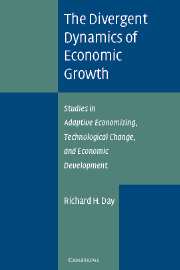 The Divergent Dynamics of Economic Growth
The Divergent Dynamics of Economic Growth Book contents
- Frontmatter
- Contents
- Preface
- Acknowledgments and Comments
- 1 The Adaptive, Evolutionary Theory of Divergent Economic Growth
- PART ONE GLOBAL TRENDS AND ADAPTIVE ECONOMICS
- 2 Global Trends, World Models, and Human Adaptation
- 3 Adaptive Economic Theory and Modeling
- PART TWO TECHNOLOGICAL CHANGE IN AGRICULTURE AND INDUSTRY
- PART THREE EPOCHAL DEVELOPMENT
- PART FOUR TOWARD A GENERAL THEORY OF DEVELOPMENT
- Index
3 - Adaptive Economic Theory and Modeling
Published online by Cambridge University Press: 08 August 2009
- Frontmatter
- Contents
- Preface
- Acknowledgments and Comments
- 1 The Adaptive, Evolutionary Theory of Divergent Economic Growth
- PART ONE GLOBAL TRENDS AND ADAPTIVE ECONOMICS
- 2 Global Trends, World Models, and Human Adaptation
- 3 Adaptive Economic Theory and Modeling
- PART TWO TECHNOLOGICAL CHANGE IN AGRICULTURE AND INDUSTRY
- PART THREE EPOCHAL DEVELOPMENT
- PART FOUR TOWARD A GENERAL THEORY OF DEVELOPMENT
- Index
Summary
The current controversy over energy policy and the apparent suddenness with which abundant supplies turn to scarcity and back again to (at least temporary) gluts – not to mention a host of other pressing economic problems like stagflation – have brought to the fore a need to improve our understanding of how the present economy works and how it can and should be controlled or modified. This chapter outlines the essential features of a diversely developing but more or less coherent approach to this task, which may be called adaptive economics, and illustrates some salient insights it affords. I begin by describing some facts of economic life that must be dealt with by a credible economic theory: typical trajectories that must be explained and characteristics of economic structure that must be accommodated. Before turning to a discussion of the theory itself, I pause to explain what adaptive economics is, not to contrast its content with some erroneous interpretations, and to establish its place in the development of economic thought. I then outline basic concepts of adaptation and evolution and summarize the primary ingredients that must be a part of an adaptive economic theory. This is followed by a brief discussion of one class of models incorporating adaptive features and generating the types of trajectories it is a part of our purpose to explain. The chapter concludes with some general observations about the nature of economic change and policy that the point of view advocated here seems to suggest.
- Type
- Chapter
- Information
- The Divergent Dynamics of Economic GrowthStudies in Adaptive Economizing, Technological Change, and Economic Development, pp. 36 - 56Publisher: Cambridge University PressPrint publication year: 2003
